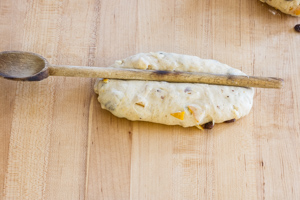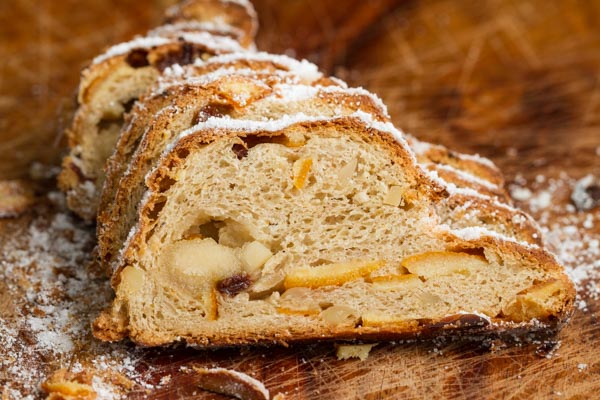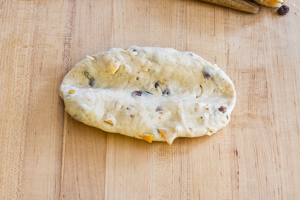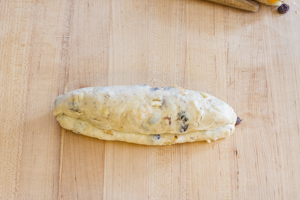I have long extolled the virtues of Stollen, the classic German holiday yeasted fruitcake, as not only one of the tastiest ways to get your holiday-bread-shaped-like-baby-Jesus-in-the-manger fix, but as an extremely easy and forgiving bread to make.
This was evident when my colleague Susan and I were charged with making the Stollen for our baking school graduation. We tossed all the ingredients into the mixer and turned our attention to the half-dozen or so other breads on our day’s agenda. Almost an hour later, our cries of “Aaaaahhhh, the Stollen!” brought our panicked instructor running, and once he determined that the bakery was not burning down, he shot us a glare that demanded to know why two grown women couldn’t manage to act more dignified (especially considering, I suppose, the hallowed origins of this bread). The forgotten Stollen, however, didn’t care at all; the mixer was chugging along, with the Stollen dough swirling cheerfully and patiently inside. Most breads are ruined by excessive mixing, but it was going to take much, much more to get this baby’s swaddling in a twist.
My Stollen this year proved itself, fittingly, to be further willing to forgive; I inadvertently left the egg out of the dough, and nothing bad happened. Butter, sugar, and rum-soaked fruit save one from a multitude of sins, it seems.
This year for the first time, I folded a small rope of marzipan inside each loaf. This is traditional in some versions, but not mandatory, so feel free to leave it out. Or use twice as much, if you prefer.
The shaping of the Stollen is slightly more involved than the mixing, but even here, whatever you do will be forgiven. (Remember: you have butter, sugar, rum-soaked fruits–and, of course, baby Jesus–on your side.) Once the dough has been divided, preshaped into balls and bench-rested, the shaping proceeds like this:
Form a blunt-ended batard and flatten it slightly with your hand. With a thin rolling pin or wooden spoon handle placed lengthwise and just off-center, press down firmly, separating the dough into two sections. Roll out the cleft connecting the sections so it is about an inch wide.

Roll marzipan (about 45 grams for a small loaf) into a rope about an inch shorter than the dough’s length. Place the marzipan rope in the cleft and tuck the dough up around the ends. Fold the smaller section of dough over to rest upon the larger one. If there are fruits on the surface, pick them off and tuck them back inside so they don’t burn during baking.

Marzipan Stollen
Yield: 1500 g (4 small loaves)
Time:
-
- Soak the fruits: 12 hours
-
- Mix and ferment sponge: 12 hours (can be simultaneous with fruit-soaking)
-
- Mix dough: 20 – 30 minutes
-
- First fermentation : 30 minutes
-
- Preshape, rest, and shape: 30 minutes
-
- Proof: 90 minutes
- Bake: 30 minutes
Soaker Ingredients:
(Note: It’s easy to make your own candied citrus peel. Here’s one recipe.)
-
- 204 g raisins
-
- 61 g candied orange peel
-
- 92 g candied lemon peel
-
- 82 g slivered almonds
- 34 g rum
Sponge Ingredients:
-
- 120 grams flour
-
- 80 grams water
- 0.1 gram instant yeast (a small pinch)
Final Dough Ingredients:
-
- 348 grams flour
-
- 53 grams milk
-
- 18.6 grams (2 Tablespoons) osmotolerant yeast or 25.3 grams (2 Tablespoons + 2 teaspoons) instant yeast
-
- 8 grams (1-1/3 teaspoons) salt
-
- 8 grams (2-1/3 teaspoons) diastatic malt powder (omit if you don’t have it)
-
- 51 grams sugar
-
- 53 grams egg (about one large egg)
-
- 5 grams grated lemon zest (one average lemon)
-
- 5 grams grated orange zest (one small orange)
-
- 1/3 teaspoon of each of these ground spices: cinnamon, cardamom, cloves, allspice, nutmeg
-
- 273 grams unsalted butter, at room temperature (should be pliable)
-
- all of the sponge
-
- all of the soaker
- about 180 grams of marzipan, divided into four pieces
Finishing Ingredients:
-
- clarified butter
-
- fine granulated sugar
- powdered (confectioner’s) sugar
Method:
-
- Combine the soaker ingredients in a medium bowl. Cover and leave at room temperature for about 12 hours.
-
- Meanwhile, combine the sponge ingredients in another medium bowl. Cover and ferment at room temperature for 12 hours.
-
- In the bowl of a stand mixer, combine all of the final dough ingredients except the soaker and the marzipan. Mix in slow speed until all the ingredients are incorporated, about 4 or 5 minutes.
-
- Continue mixing in medium speed until the gluten reaches full development. The dough should come together around the hook and should no longer stick to the sides and bottom of the bowl. This could take about 20 minutes or more, but will depend on your mixer.
-
- Add the soaked fruits and mix on slow speed just until they are evenly distributed through the dough.
-
- Transfer the dough to a lightly buttered container. Cover and ferment for 30 minutes at room temperature.
-
- Turn the dough onto the counter. Divide into four pieces of about 375 grams each. Preshape the dough into balls and let them rest, covered, for 30 minutes.
-
- Shape the loaves as shown above and place them on parchment-lined baking sheets (two per sheet). Slip them into a large plastic bag with a bowl of warm water. Proof for about 90 minutes, replenishing the water when it cools.
-
- Meanwhile, preheat the oven to 375F on convection setting or 400F on regular bake setting. You will also need steam during the initial phase of baking, so prepare for this now.
-
- Bake for 10 minutes, open the oven door briefly to allow any remaining steam to escape, and bake for another 15-20 minutes. If you do not have convection, you may need to rotate the position of the baking sheets halfway through the bake to ensure even browning.
-
- While the loaves are still warm, brush them with clarified butter. Dredge them in fine granulated sugar, brushing off the excess.
-
- When cool, sift powdered sugar over the loaves. You can leave the stollen out overnight to let the loaves dry and the sugar crust up a bit.
-
- To store, wrap tightly in foil; it will keep for several days.
- To serve, slice thinly.



